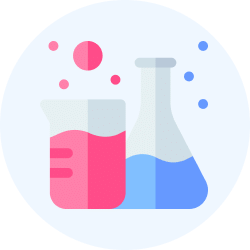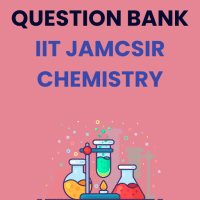Chemistry Exam > Chemistry Questions > How many of the following are reducing sugar:...
Start Learning for Free
How many of the following are reducing sugar:
Sucrose, Lactose, Maltose, Glucose, Galactose, Fructose, Glycogen, Ribose.
Correct answer is '7'. Can you explain this answer?
Most Upvoted Answer
How many of the following are reducing sugar:Sucrose, Lactose, Maltose...
The aldehyde group of aldoses is very susceptible to oxidation, whereas ketoses are less so, but can easily be oxidized if, like fructose, they contain an α-hydroxyl and can tautomerize to an aldose. Most monosaccharides are reducing sugars. This includes all of the common ones galactose, glucose, fructose, ribose, xylose, and mannose. Some disaccharides, such as lactose and maltose are reducing sugars since they have at least one anomeric carbon free, allowing that part of the sugar to linearize and yield an aldose.
Free Test
FREE
| Start Free Test |
Community Answer
How many of the following are reducing sugar:Sucrose, Lactose, Maltose...
Reducing Sugars in the List
Sucrose
- Sucrose is a disaccharide composed of glucose and fructose.
- It is a non-reducing sugar since it does not have a free anomeric carbon that can form a hemiacetal bond with another compound.
Lactose
- Lactose is a disaccharide composed of glucose and galactose.
- It is a reducing sugar since it has a free anomeric carbon on the glucose molecule that can form a hemiacetal bond with another compound.
Maltose
- Maltose is a disaccharide composed of two glucose molecules.
- It is a reducing sugar since it has a free anomeric carbon on each glucose molecule that can form a hemiacetal bond with another compound.
Glucose
- Glucose is a monosaccharide and is a reducing sugar.
- It has a free anomeric carbon that can form a hemiacetal bond with another compound.
Galactose
- Galactose is a monosaccharide and is a reducing sugar.
- It has a free anomeric carbon that can form a hemiacetal bond with another compound.
Fructose
- Fructose is a monosaccharide and is a reducing sugar.
- It has a free anomeric carbon that can form a hemiacetal bond with another compound.
Glycogen
- Glycogen is a polysaccharide composed of glucose molecules.
- It is a non-reducing sugar since it does not have a free anomeric carbon that can form a hemiacetal bond with another compound.
Ribose
- Ribose is a monosaccharide and is a reducing sugar.
- It has a free anomeric carbon that can form a hemiacetal bond with another compound.
Conclusion
Out of the given list, the reducing sugars are lactose, maltose, glucose, galactose, fructose, and ribose. Sucrose and glycogen are non-reducing sugars. Therefore, the correct answer is 7.
Sucrose
- Sucrose is a disaccharide composed of glucose and fructose.
- It is a non-reducing sugar since it does not have a free anomeric carbon that can form a hemiacetal bond with another compound.
Lactose
- Lactose is a disaccharide composed of glucose and galactose.
- It is a reducing sugar since it has a free anomeric carbon on the glucose molecule that can form a hemiacetal bond with another compound.
Maltose
- Maltose is a disaccharide composed of two glucose molecules.
- It is a reducing sugar since it has a free anomeric carbon on each glucose molecule that can form a hemiacetal bond with another compound.
Glucose
- Glucose is a monosaccharide and is a reducing sugar.
- It has a free anomeric carbon that can form a hemiacetal bond with another compound.
Galactose
- Galactose is a monosaccharide and is a reducing sugar.
- It has a free anomeric carbon that can form a hemiacetal bond with another compound.
Fructose
- Fructose is a monosaccharide and is a reducing sugar.
- It has a free anomeric carbon that can form a hemiacetal bond with another compound.
Glycogen
- Glycogen is a polysaccharide composed of glucose molecules.
- It is a non-reducing sugar since it does not have a free anomeric carbon that can form a hemiacetal bond with another compound.
Ribose
- Ribose is a monosaccharide and is a reducing sugar.
- It has a free anomeric carbon that can form a hemiacetal bond with another compound.
Conclusion
Out of the given list, the reducing sugars are lactose, maltose, glucose, galactose, fructose, and ribose. Sucrose and glycogen are non-reducing sugars. Therefore, the correct answer is 7.

|
Explore Courses for Chemistry exam
|

|
Question Description
How many of the following are reducing sugar:Sucrose, Lactose, Maltose, Glucose, Galactose, Fructose, Glycogen, Ribose.Correct answer is '7'. Can you explain this answer? for Chemistry 2025 is part of Chemistry preparation. The Question and answers have been prepared according to the Chemistry exam syllabus. Information about How many of the following are reducing sugar:Sucrose, Lactose, Maltose, Glucose, Galactose, Fructose, Glycogen, Ribose.Correct answer is '7'. Can you explain this answer? covers all topics & solutions for Chemistry 2025 Exam. Find important definitions, questions, meanings, examples, exercises and tests below for How many of the following are reducing sugar:Sucrose, Lactose, Maltose, Glucose, Galactose, Fructose, Glycogen, Ribose.Correct answer is '7'. Can you explain this answer?.
How many of the following are reducing sugar:Sucrose, Lactose, Maltose, Glucose, Galactose, Fructose, Glycogen, Ribose.Correct answer is '7'. Can you explain this answer? for Chemistry 2025 is part of Chemistry preparation. The Question and answers have been prepared according to the Chemistry exam syllabus. Information about How many of the following are reducing sugar:Sucrose, Lactose, Maltose, Glucose, Galactose, Fructose, Glycogen, Ribose.Correct answer is '7'. Can you explain this answer? covers all topics & solutions for Chemistry 2025 Exam. Find important definitions, questions, meanings, examples, exercises and tests below for How many of the following are reducing sugar:Sucrose, Lactose, Maltose, Glucose, Galactose, Fructose, Glycogen, Ribose.Correct answer is '7'. Can you explain this answer?.
Solutions for How many of the following are reducing sugar:Sucrose, Lactose, Maltose, Glucose, Galactose, Fructose, Glycogen, Ribose.Correct answer is '7'. Can you explain this answer? in English & in Hindi are available as part of our courses for Chemistry.
Download more important topics, notes, lectures and mock test series for Chemistry Exam by signing up for free.
Here you can find the meaning of How many of the following are reducing sugar:Sucrose, Lactose, Maltose, Glucose, Galactose, Fructose, Glycogen, Ribose.Correct answer is '7'. Can you explain this answer? defined & explained in the simplest way possible. Besides giving the explanation of
How many of the following are reducing sugar:Sucrose, Lactose, Maltose, Glucose, Galactose, Fructose, Glycogen, Ribose.Correct answer is '7'. Can you explain this answer?, a detailed solution for How many of the following are reducing sugar:Sucrose, Lactose, Maltose, Glucose, Galactose, Fructose, Glycogen, Ribose.Correct answer is '7'. Can you explain this answer? has been provided alongside types of How many of the following are reducing sugar:Sucrose, Lactose, Maltose, Glucose, Galactose, Fructose, Glycogen, Ribose.Correct answer is '7'. Can you explain this answer? theory, EduRev gives you an
ample number of questions to practice How many of the following are reducing sugar:Sucrose, Lactose, Maltose, Glucose, Galactose, Fructose, Glycogen, Ribose.Correct answer is '7'. Can you explain this answer? tests, examples and also practice Chemistry tests.

|
Explore Courses for Chemistry exam
|

|
Signup for Free!
Signup to see your scores go up within 7 days! Learn & Practice with 1000+ FREE Notes, Videos & Tests.



















